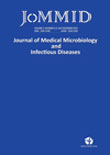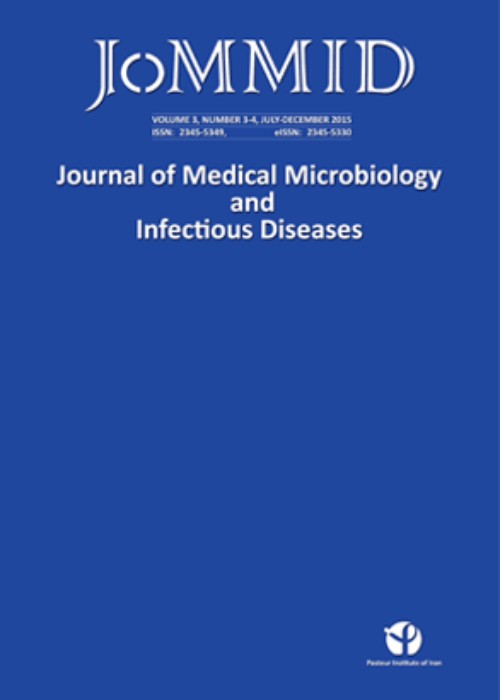فهرست مطالب

Journal of Medical Microbiology and Infectious Diseases
Volume:5 Issue: 1, Winter-Spring 2017
- تاریخ انتشار: 1395/12/20
- تعداد عناوین: 8
-
-
Pages 1-11Leishmaniasis is now accounted as a health problem and categorized as a class I disease (emerging and uncontrolled) by World Health Organization (WHO), causing highly significant morbidity and mortality with different clinical presentations. The incidence of human leishmaniasis is increasing and its geographic distribution in humans and animals is shown to be wider than estimated before. Indeed, more than 350 million people are at risk of Leishmania infection, and about 1.6 million new cases occur causing more than 50 thousand death annually. Control of leishmaniasis is highly dependent to the early diagnosis and treatment of the disease. In recent years, there have been advances in diagnosis of Leishmania infection. However, the main challenge in Leishmania diagnosis is the lack of a gold standard test in order to establish an effective strategic program to control and eradicate the disease. This review provides the latest information regarding the diagnosis of the disease, which is based on a combination of clinical features (supported by epidemiologic data) and laboratory tests including direct parasitological (microscopy, histopathology, and parasite culture), serological and molecular tests.Keywords: Leishmaniasis, Leishmania, diagnosis
-
Pages 12-16IntroductionProbiotics are defined as live non-pathogenic microorganisms and if administered in adequate amounts, can have beneficial effects on their hosts. This study aimed to isolate Gram-positive bacteria from different sources and to evaluate their probiotic properties.MethodsWe obtained five samples from various sources including yogurt, infant feces, cheese, and soil under aseptic methods. The samples were inoculated on MRS agar and M17 medium. Biochemical assays identified isolated bacteria. The probiotic effect of isolated bacteria was tested by applying acidic pH 2.0, 0.3% w/v bile salt concentration and gastric juice in the samples. The antibiotic susceptibility profiling and their antimicrobial effects against Escherichia coli, Staphylococcus aureus, Salmonella enterica and Pseudomonas aeruginosa, were determined.ResultsFour Gram-positive bacteria including Lactobacillus acidophilus, Bifidobacterium bifidum, Lactococcus lactis and Bacillus subtilis were isolated from yogurt, infant feces, cheese, and soil, respectively. Except for B. subtilis, all the isolated bacteria were catalase-negative and non-motile. The results showed that viable count of L. acidophilus, B. bifidum, and L. lactis was significantly high (PConclusionThe species L. acidophilus, B. bifidum, and L. lactis fulfilled the criteria for probiotic properties and can be used in field conditions as probiotics.Keywords: Identification, Gram, Positive Bacteria, Probiotic
-
Pages 17-20IntroductionUrinary tract infection (UTI) is one of the most common infectious diseases, and Escherichia coli is known as the most dominant causative agent of this infection in 90-80% of patients. There is not much information about the phylogenetic groups, types, and virulence factors of E. coli, causing UTIs from Iran. The objective of this study was to evaluate the antimicrobial susceptibility of E. coli strains isolated from patients with UTI and to determine the phylogenetic classification of the strains.MethodsIn this cross-sectional study, 100 E. coli isolates were collected from patients with UTI from five laboratories in Rasht city. The isolates were confirmed by using morphological and biochemical common tests. The frequency of virulence genes and patterns of phylogenetic groups were performed using Multiplex PCR. Additionally, antimicrobial susceptibility of all isolates was evaluated by disk diffusion method.ResultsDistribution of phylogenetic B2, D, A and B1 groups in the isolates were 64%, 24%, 12%, and 0%, respectively. The highest antibiotic resistance was reported to cefotaxime (84%), piperacillin, and cefixime (80%), and the lowest resistance was demonstrated to imipenem (8%), chloramphenicol and gentamicin (12%).ConclusionOur findings showed that the B2 was the most prevalent phylogenetic group and the most resistant strain to generally used antibiotics among patients with UTI.Keywords: Escherichia coli, Multiplex PCR, Urinary Tract Infection
-
Pages 21-25IntroductionRodents are the primary source of several zoonotic infectious diseases. The upsurge of rodents population in Najaf Abad Village of Nishapur County, northeastern Iran in February 2014 raised the concerns about the outbreak of diseases such as plague and tularemia. This report discusses the lessons learned from the outburst of rodents population in that village and represent as well the investigations performed by a dispatched team from Pasteur Institute of Iran for detection of potentially pathogenic agents in the entrapped rodents.MethodsIn this study, different areas of Najaf Abad village were explored. The animals were identified based on morphological features using identification keys. Sera from all rodents were tested for plague and tularemia using ELISA and agglutination tests, respectively.ResultsSeven captured rodents belonged to the family Muridae Illiger, 1811, and the species, Mus musculus Linnaeus, 1758 (n=4), Meriones libycus Illiger, 1811 (n=2), and Nesokia indica Gray, 1830 (n=1) were identified. All the rodents were negative for plague and tularemia.ConclusionThe outburst rodents populations in this village that began in 2007 can be attributed to the old structure of the village, drought, and the disappearance of natural predators of rodents. Also, due to drought in the recent years, extensive agriculture was not possible, which might have led to the invasion of rodents to the human settlements. It is recommended that in such events, regular programs to be carried out under the supervision of an organization to achieve the best results in the shortest possible time.Keywords: Rodent, borne Diseases, Plague, Tularemia, Zoonoses, Outbreaks
-
Pages 26-30IntroductionThe term Leishmaniasis applies to a group of parasitic diseases caused by the genus Leishmania. Route of infection is one of the variables that have been reported to influence the immune responses as well as the disease outcome in experimental models of leishmaniasis. This research aims to study the effect of route of infection on the pathogenicity of Leishmania major in BALB/c mice.MethodsLow (103 parasites/mouse) and high (106 parasites/mouse) doses of L. major was injected into footpad or ear dermis of BALB/c mice. Lesion diameter was determined throughout the study. Parasite load of draining lymph nodes and spleen were assessed at three intervals.ResultsFootpad in comparison to ear route showed higher pathogenicity of L. major in BALB/c mice as assessed by lesion diameter, parasite load in the draining lymph node, and dissemination of the parasite to the spleen.ConclusionOur findings suggest that substantial differences between footpad and ear route need particular attention when we use experimental models for the study of Leishmania infections.Keywords: Leishmania major, Pathogenicity, Administration Routes, Viscera, BALB, c mice
-
Pages 31-34IntroductionSome postgraduate students reported the presence of a nematode infection, presumably, Trichosomoides crassicauda in the urinary bladder of rats (Rattus norvegicus) from the animal house of Tehran University of Medical Sciences (TUMS). We prompted to explore the prevalence of this infection among the rats of animal houses belonging to medical and veterinary research centers in Tehran. We also described the histopathological changes in the bladder tissue of the infected rats.MethodsWe collected 214 adult rats (R. norvegicus) from four animal houses including TUMS in Tehran. The urine of 112 animals was collected during 24 h and inspected microscopically for helminths eggs. Then, the rats were euthanized, sacrificed and dissected; their bladders were removed and examined under a stereomicroscope for the presence of worms and histopathological changes.ResultsOut of 112 urine samples checked, 16 contained T. crassicauda eggs. Out of 214 rats, 114 showed infection urinary bladder with the nematode T. crassicauda. The histopathological changes in the urinary bladder included hyperemia, edema, hyperplasia, and metaplasia. In the transitional epithelium, the features of gravid female nematodes, with an egg-filled uterus were visible.ConclusionTrichosomoides crassicauda is a prevalent infection in laboratory rats of research centers in Tehran and its identification cannot be made merely based on urine examination of the rats.Keywords: Trichosomoides crassicauda, Laboratory Rats, Histopathological Changes
-
Pages 35-37Pneumococcal endocarditis is an uncommon disease. Here, we describe a case of endocarditis caused by Streptococcus pneumoniae in a young man following a nose trauma. In traumas that involve the respiratory system and the mucous membrane, bacterial complications such as colonization and bacteremia and end-organ involvement should be considered by physicians.
-
Pages 38-39Nocardia is a genus of weakly gram-positive, filamentous, aerobic, relatively slow-growing and partially acid-fast bacteria. These bacteria are ubiquities in environmental resources such as water, soil, dust, decomposing animal feces, and vegetables. This group of bacteria can enter the human body through inhalation and traumatic cutaneous inoculation and cause Nocardia infections. There are various types of nocardiosis including pulmonary, brain, cutaneous, cutaneous-lymphatic, and ocular infections. These infections often occur in immunocompromised patients including organ transplant recipients, corticosteroid drugs consumers, human immunodeficiency virus (HIV) patients, cancerous and even healthy individuals.Keywords: Nocardia asteroides, Species Level, Nocardia


